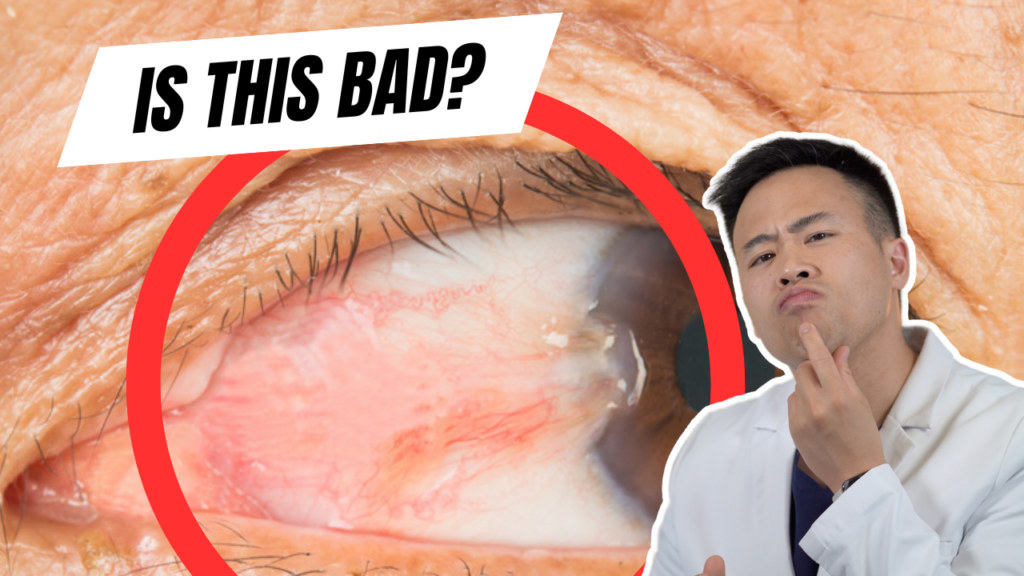Table of Contents
Is It Just a Pterygium, or Something More Serious?
If you’ve been worried about a strange growth on your eye or wondering if it’s something serious, you’re in the right place. Could it just be a pterygium, or could it be something more concerning, like ocular surface squamous neoplasia (OSSN), a form of eye cancer?
Here’s a surprising fact: while pterygium is non-cancerous, OSSN is a form of eye cancer that might look similar but requires a completely different approach. In this post, we’ll help you understand the difference and explain how to prevent and treat both conditions.
For more information, check out the YouTube video here.
What Is a Pterygium?
A pterygium is a non-cancerous growth of tissue that develops on the conjunctiva, the clear membrane covering the white part of your eye. It often extends onto the cornea, the clear dome at the front of your eye. It’s usually triangular in shape and can vary in size.
Early on, it may appear as a small bump. When it hasn’t yet crossed onto the cornea, we call it a pinguecula.
Why Is It Called Surfer’s Eye?
The term “surfer’s eye” might suggest it only affects surfers, but in reality, anyone who spends significant time outdoors is at risk. This is because UV exposure from the sun is a leading cause of pterygium. Other risk factors include:
- Exposure to wind and dust
- Living in sunny climates
- Dry eye conditions
Signs and Symptoms
Not all pterygia cause symptoms, but some common ones include:
- Redness and irritation
- A gritty feeling, like there’s something in your eye
- Blurred vision, especially if the growth affects the cornea
- Cosmetic concerns—some people feel self-conscious about the appearance of their eyes
How to Prevent a Pterygium
Since the main risk factors for pterygium include sunlight, wind, dust, and dry eyes, all prevention tips focus on minimizing these exposures:
- Wear Sunglasses: Choose sunglasses that block 100% of UVA and UVB rays. Bonus points if they’re wraparound styles to protect against wind and dust.
- Use Hats: A wide-brimmed hat adds extra shade and protection for your eyes.
- Keep Your Eyes Moisturized: Use artificial tears to keep your eyes hydrated, especially in dry or dusty environments.
- Avoid Excessive Sun Exposure: Try to stay indoors during peak sunlight hours (10 AM to 4 PM) when UV rays are strongest.
How Do We Treat a Pterygium?
If you already have a pterygium, don’t worry—there are treatments available! Here’s what we typically do:
Mild Cases:
- Artificial tears can help reduce dryness and irritation.
- Anti-inflammatory eye drops, like steroid drops, may be prescribed if redness or discomfort is a concern.
Moderate to Severe Cases:
- If the pterygium grows large enough to affect your vision or cause significant discomfort, surgical removal may be recommended.
- The surgery involves carefully removing the growth and often using a graft from another part of your eye to prevent recurrence.
- Speaking of recurrence, pterygia can return after surgery, but modern techniques have improved outcomes significantly.
How Does This Differ from Ocular Surface Squamous Neoplasia (OSSN)?
Now, you might be wondering how pterygium differs from another condition called ocular surface squamous neoplasia (OSSN). While they can look similar, there are some key differences:
Cause:
- Pterygium is typically caused by UV exposure, wind, and dry conditions.
- OSSN is a type of cancer that may be linked to factors like HPV infection or immune suppression. UV exposure also increases the risk of OSSN, so minimizing sunlight exposure with sunglasses and hats is essential.
Appearance:
- Pterygium usually has a fleshy, triangular shape and grows slowly.
- OSSN can appear as a white, gelatinous, or plaque-like lesion, and it may grow more aggressively.
Treatment:
- Pterygium is usually treated with artificial tears, anti-inflammatory drops, or surgery for severe cases.
- OSSN often requires more advanced treatments like biopsy, excision, or even chemotherapy drops to ensure complete removal.
If you’re ever unsure about what’s going on with your eyes, always consult an eye doctor for a proper diagnosis and treatment plan.
Final Thoughts
To recap, a pterygium is a common but manageable eye condition. Protecting your eyes from UV rays and keeping them hydrated can go a long way in preventing it. If you already have one, don’t hesitate to talk to your eye doctor about your options. Early treatment can save you a lot of discomfort—and possibly your vision.
If you found this post helpful, be sure to share it with someone who spends a lot of time in the sun!

